Month: July 2023
Where have Staten Island’s LGBTQ+ bars gone? How a once-vibrant scene has shifted in the 2020s
June 22, 2023
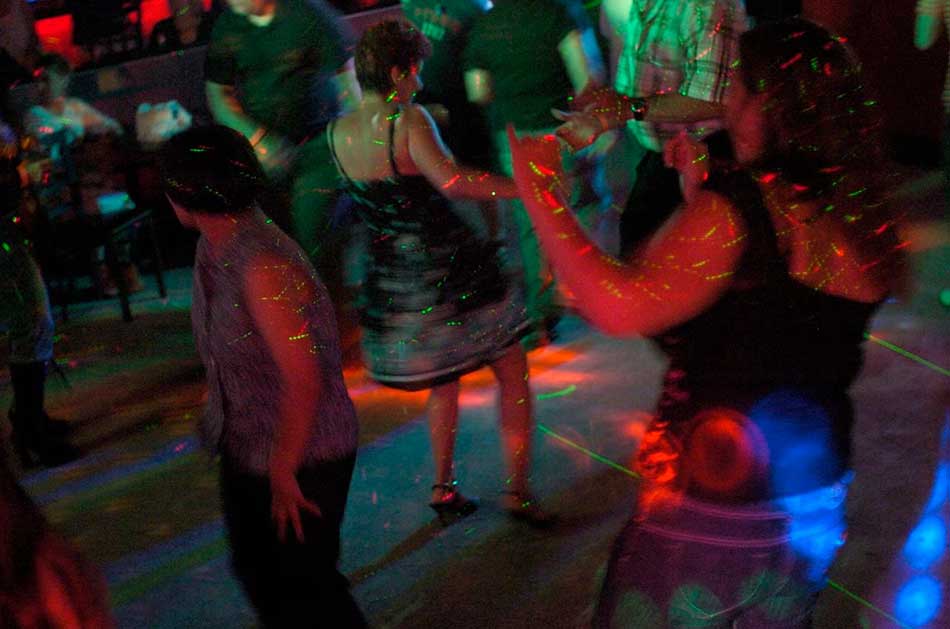
EDITOR’S NOTE: “Pride 2023″ is a collection of Staten Islanders’ stories. Whether it’s about overcoming adversity, a parent’s journey in accepting their LGBTQ child, or fighting for awareness and equality, these borough residents all have Pride.
STATEN ISLAND, N.Y. – For as long as Chris Bauer can remember, Staten Island has been home to a small share of bars that cater to a lesbian, gay, bisexual and transgender crowd. Clustered on the North Shore, earning their popularity in the 1980s and ‘90s, each establishment was considered a safe haven for a not-yet universally accepted LGBTQ+ portion of the borough community.
Naming watering holes like Beach Haven, Sand Castle and the Mayfair Bar & Grill, Bauer, a Stapleton resident has been a force for the borough’s LGBTQ+ community for years. He explained that bars geared toward LGBTQ+ individuals have always been “a thing” on Staten Island – even if they were hiding in plain sight. But according to the inclusivity advocate, each location just didn’t seem to have much staying power.
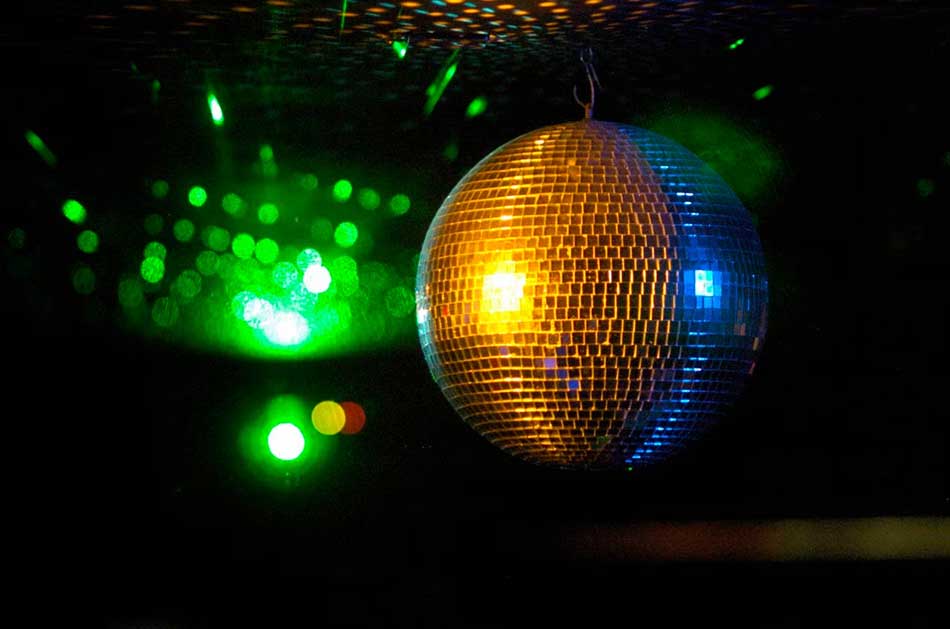
“There was nothing nefarious about them,” Bauer continued. “Just a place for gay people to gather. But like any bar, popularity comes and goes. And now – in Staten Island anyway – they are all gone. But that’s mostly because I think gay bars are just no longer the social hubs they once were.”
According to the NYC LGBT Historic Sites Project, several gay bars have historically existed in Staten Island, some dating back as early as the 1950s. The Mayfair was the most popular, located on Hyatt Street directly across from Borough Hall. The Beach Haven on Father Capodanno Boulevard was a gathering spot for local women’s softball teams and was considered the first official meeting place of Lambda Associates, the main LGBT group on Staten Island. Park Villa II, located in the former Liberty Theater on Beach Street, thrived during the late ‘80s, early ‘90s, the Project notes, but fizzled in popularity in the 2000s. In 2009, Q-SINY, a nightclub, opened in Midland Beach, only to close a year later.
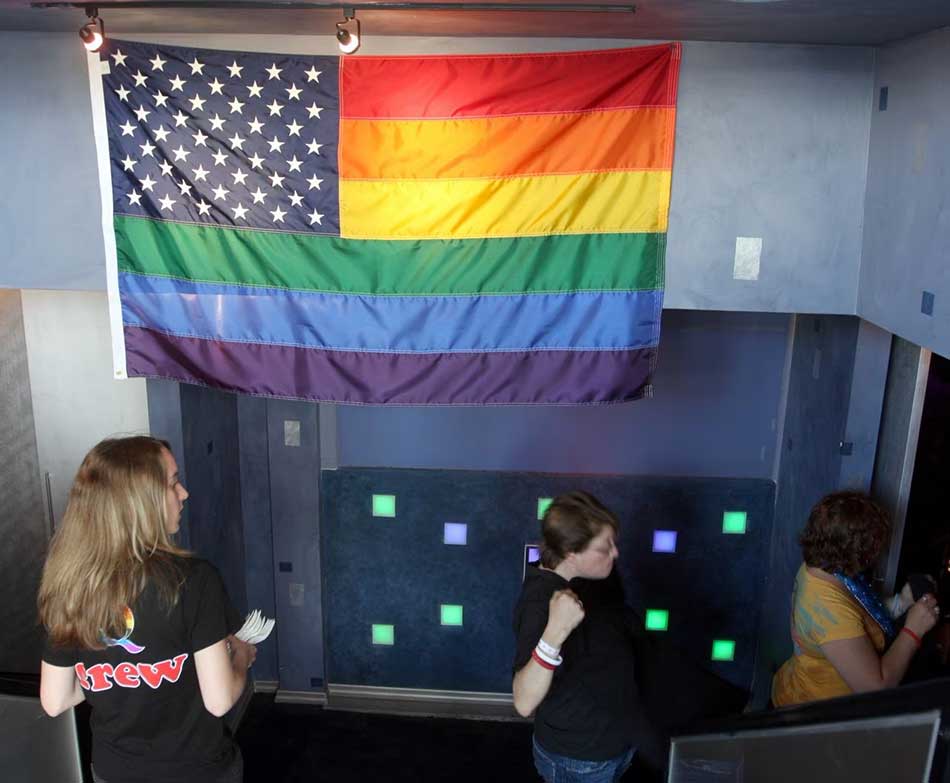
“Gay bars – which were once social hubs — are not really as necessary as they once were,” he said. “I think part of it is because the internet killed them off and part of it is acceptance. At one point we needed a safe space, but now, for the most part, the gay culture is universally accepted. The decline of the gay bar is not necessarily a bad thing.”
Bauer notes that it’s not just establishments geared toward LGBTQ+ individuals that have waned; the entire bar culture has sputtered too.
“There used to be so many neighborhood bars, but that culture has changed,” Bauer said. “Young people – gay, straight or otherwise – don’t go out like they used to. They meet on apps and chat on social media. The good old-fashioned pick-up joint seems to be a thing of the past.”
Bauer is right. According to a report from the NYC Mayor’s Office of Media and Entertainment, Staten Island has the smallest share of nightlife venues in the city. There’s a total of 800 food service, bars and sports and recreation establishments here, the report notes, a stark contrast from the 13,000 located in Manhattan or the 5,500 and 4,800 found in Brooklyn and Queens. And not one of Staten Island’s 800 venues is LGBTQ+ focused.
Carol Bullock, executive director of the Pride Center of Staten Island, agrees with those findings.
“There are several Staten Island bars and restaurants that are LGBTQ+-friendly — places that host drag brunches and other events that welcome our community in — but the days of having a specific spot where you knew you were going to see people just like you seem to be over.”
And while Bullock feels it’s important for the LGBTQ+ community to have a place to gather, she does not believe the absence of those establishments in the borough signal Staten Island’s ignorance.
“I don’t think it has been because of backlash,” Bullock said when questioned about why LGBTQ+ bars have failed to survive on Staten Island. “Of course, there is always some negativity but I don’t see that as the root cause.”
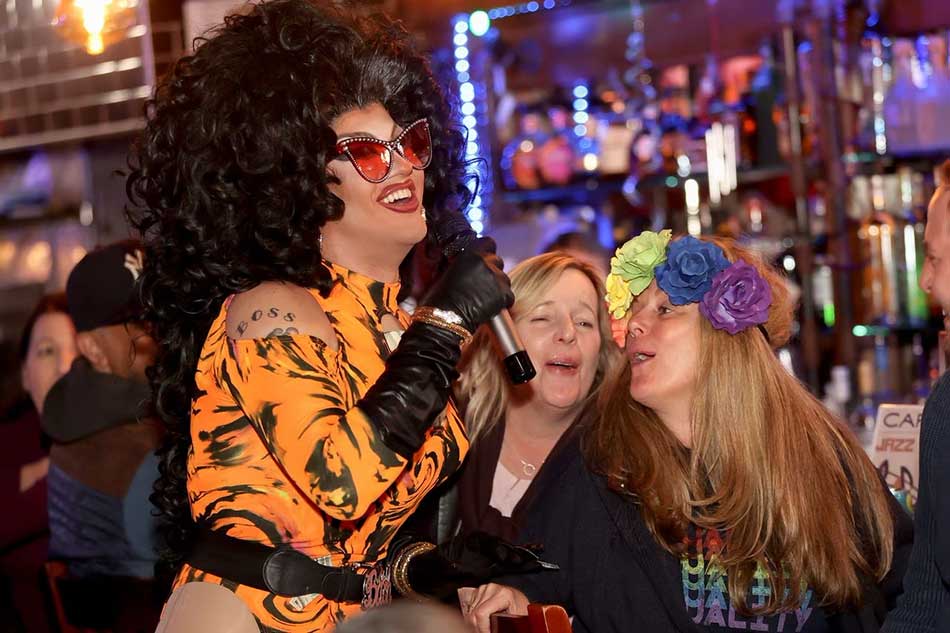
Michael Musto, who has owned the Cargo Café in St. George for about five years, says he tries his best to make all feel welcome in his establishment.
“Cargo has always been known as an alternative bar; no labels, anybody and everybody is welcome here,” noted Musto. “I have a pride flag in my window at all times and I have not lost customers because of it, in fact I think I’ve gained business.”
And while Musto says it’s sad to think that the era of the gay bar might be coming to a close, he also views the decline as the rainbow at the end of the storm.
“The lack of demand for these places means that the gay community is more accepted now,” he concluded. “A safe haven is no longer a necessity. And that is something to celebrate.”
NYC Tour of West Village with NYRR & LGBT Historical Sites Project
June 1, 2023
Come with us on a walking tour of the West Village with New York Road Runners’ LGBTQIA+ Employee Resource Group (ERG) and NYC LGBT Historic Sites Project, as we uncover the invisible history of historic places connected to New York City’s LGBTQIA+ community. 🏳️🌈🏳️⚧️
Stonewall riots history comes to life in a NYC park with help from ‘talking’ statues and Tony-winning star J. Harrison Ghee
June 21, 2023
By: Muri Assunção
LGBTQ history is coming to life with a little help from four “talking” statues and the voices of five Broadway actors.
In the recently launched “Talking Statues at Christopher Park” project, Tony-winning actor J. Harrison Ghee and theater stars Jenn Colola, Rosa Gilmore, Claybourne Elder and Conrad Ricamora lend their voices to the long-standing “Gay Liberation” statues in the West Village park, helping to illustrate the history of the 1969 Stonewall riots from a different perspective through audio clips accessed with a QR code on a mobile phone.
They tell of the origins of the country’s first national monument dedicated to LGBTQ history, as well as the violent clashes between patrons of the Stonewall Inn and New York police that marked a turning point in the fight for LGBTQ equality.
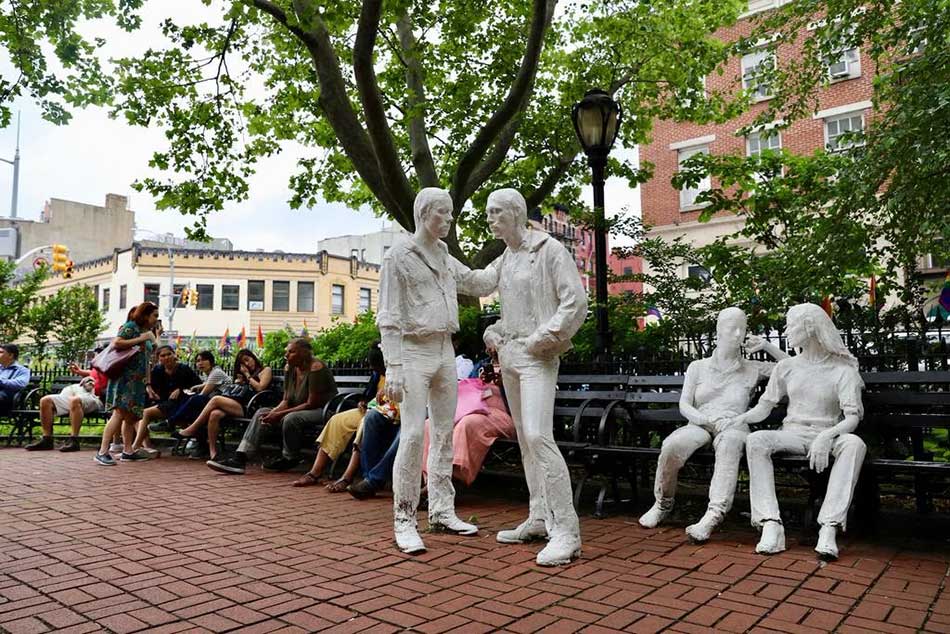
In New York, there are more than 30 sculptures across the city that already use the “Taking Statues” technology, but the Christopher Park project is the first in the nation to directly address LGBTQ history.
The installation is the result of a collaboration between two award-winning organizations dedicated to preserving and honoring the city’s rich LGBTQ history — the hit podcast “Making Gay History” and the NYC LGBT Historic Sites Project.
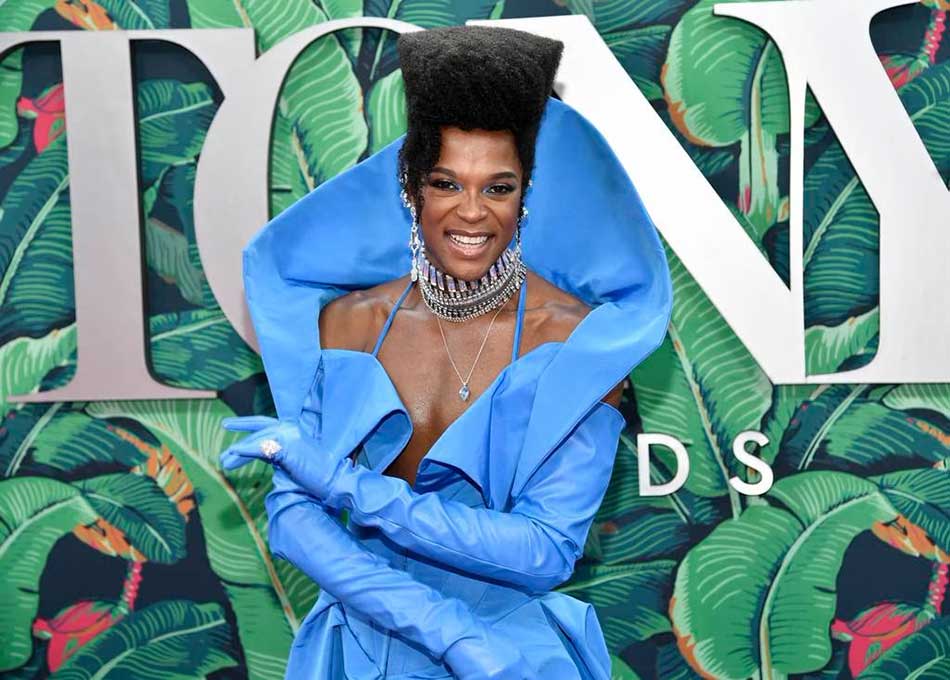
Ghee, who made history last week as the first nonbinary actor to win a Tony Award for their portrayal of Jerry/Daphne in the musical “Some Like It Hot,” plays the role of Christopher Park itself.
The four other voices, played by openly LGBTQ actors, bring life to the models who were immortalized by George Segal’s realistic sculptures in the late 1970s.
The two women represented in the statues — Leslie Cohen and Beth Suskin — were a real-life couple, while the two male models were not romantically involved. One of the men, the late David Boyce, was a friend of the artist. The identity of the other man is still a mystery, says Ken Lustbader, co-founder of the NYC LGBT Historic Sites Project.
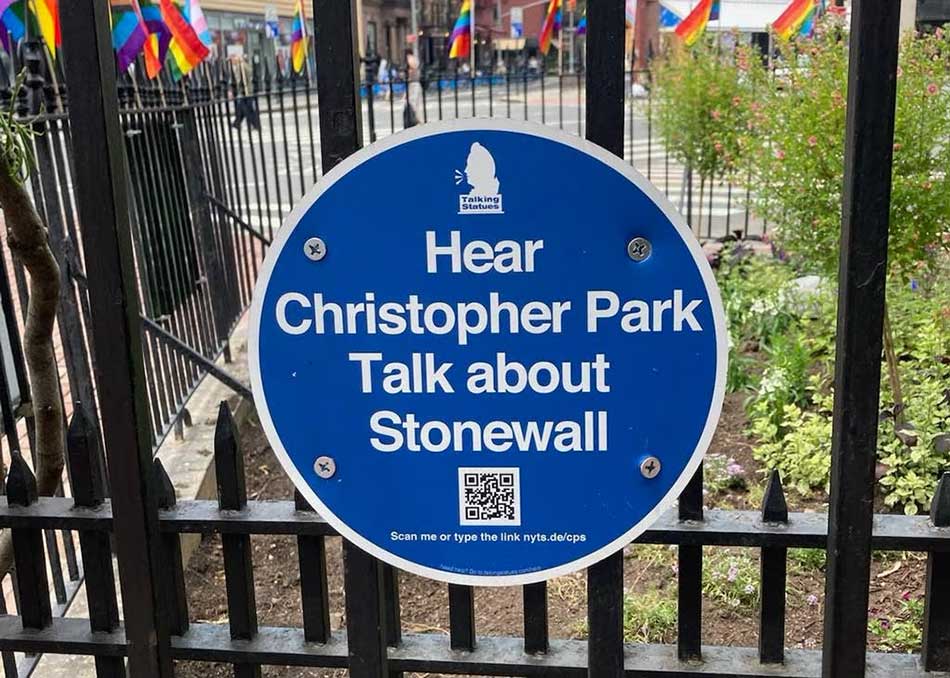
When commissioned, it was specified the “Gay Liberation” statues “had to be loving and caring, and show the affection that is the hallmark of gay people.” They were also to include equal representation of women and men.
However, the monument, which found its permanent home in Christopher Park in 1992, has since been criticized by some members of the LGBTQ community, who have taken issue with its lack of representation — which is something the four talking statues talk about.
VIDEO: NYC Pride Grand Marshal reflects on being one of nation’s first gay rights activists
June 21, 2023
By: Chris Welch
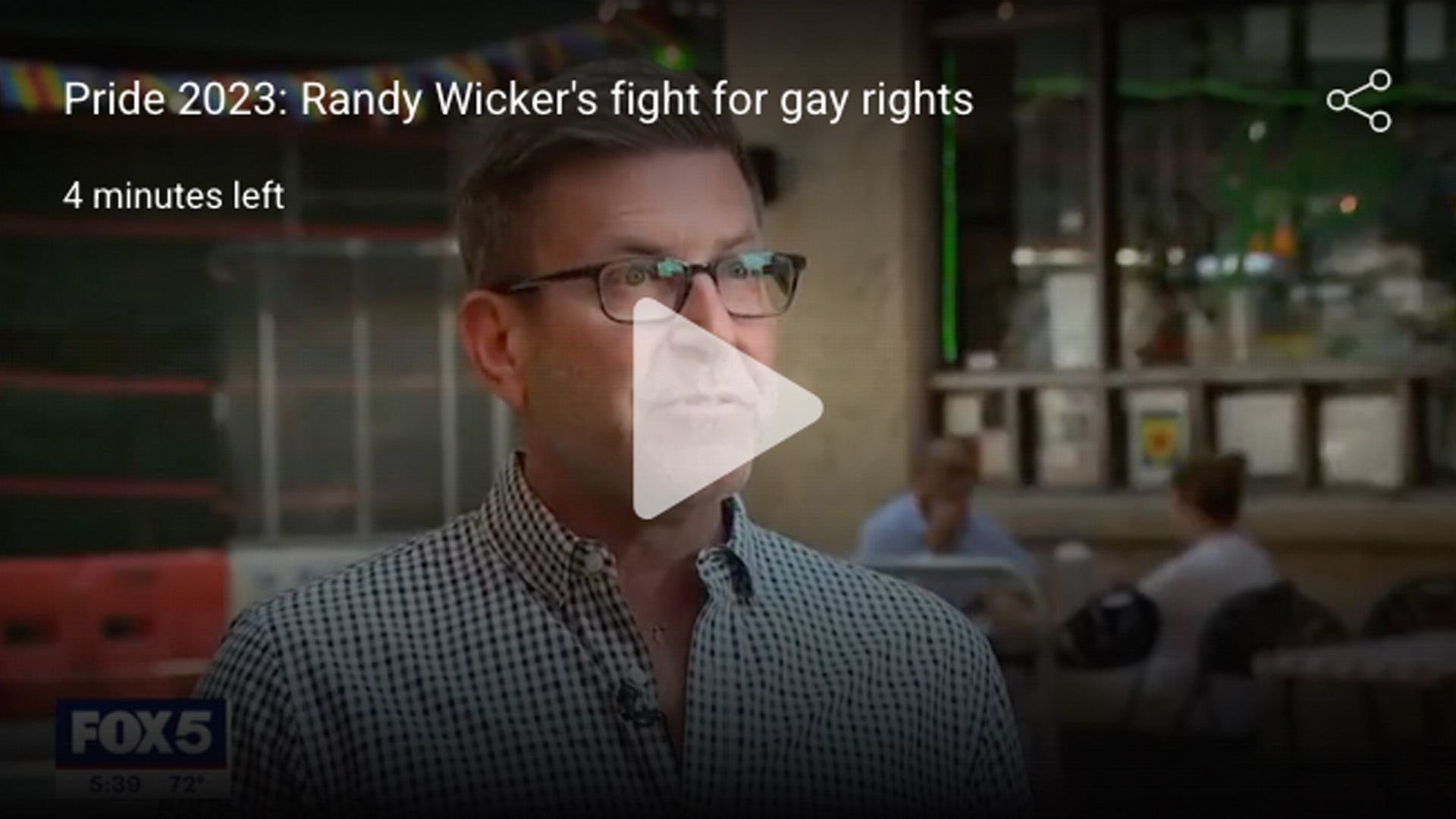
NEW YORK – For so many members of the LGBTQ+ community— especially those of a certain generation— a gay bar was the only place you could go where you weren’t compelled to lie about who you were.
“They had nowhere else to meet—publicly,” said Ken Ludstbader is co-founder of the NYC LGBT Historic Sites Project. “People could lose their jobs, people could lose their families, employment, and religious associations. So bars became really safe spaces.”
But the gay bar of the past was much different than the one we think of today, every inch covered in rainbow flags.
“In many cases, they were private clubs where there was a bouncer at the door, they were bottle clubs, you had a sign, a fictitious name in many cases,” Ludstbader said.
Lustbader says that was all because of New York’s laws. After prohibition, New York formed the State Liquor Authority, which had a regulation telling bar owners they could lose their license if they served “disorderly people.”
Homosexuals at the time were considered disorderly people. So to find a place to drink you’d have to either rely on word of mouth or know how to find an underground guidebook listing places considered safe— places like Julius’ Bar in Greenwich Village.
In 1966, Julius’ was being closely monitored by state liquor authorities for prior infractions.
That’s what brings us to one of the grand marshals of NYC Pride 2023. Randy Wicker was among a group of gay men who knew the bar was being watched with a careful eye by the state, and they thought there was a good chance they’d be denied a drink. So they brought a photographer to capture the scene.
And that’s exactly what happened. That photo is now framed on Julius’ wall behind the bar.
“We were saying, ‘We are homosexuals, and we want to order a cocktail,’” Wicker, now 85 years old, recalls.
They were denied. That incident became known as the Sip-In.
“That would be the first case of discrimination against homosexuals actually actively documented,” Lustbader said.
And it all happened three years prior to the Stonewall Riots, widely seen as the birthplace of the modern gay rights movement.
Last year, Julius’ was granted landmark status by the city.
“Let this designation serve as an important reminder to everyone that LGBTQ+ history is New York City history,” Mayor Eric Adams said in a statement.
“Like Julius’, the City of New York will always serve as a safe haven for LGBTQ+ people to be safe and feel safe.”
Check out this Pride pop-up museum at JFK Terminal 4
June 19, 2023
By: Ethan Marshall
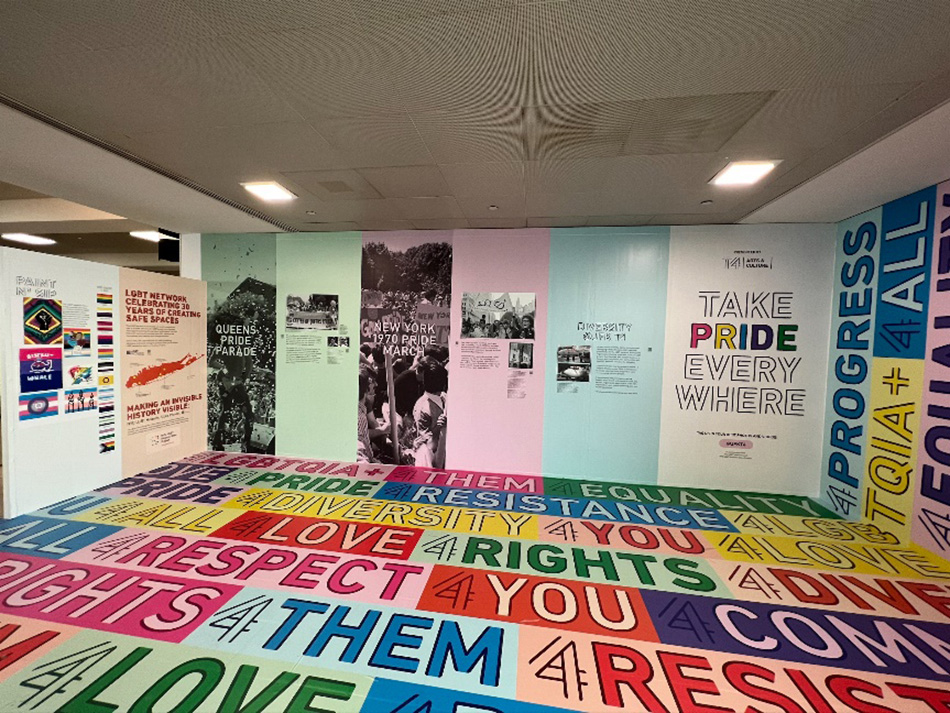
JFKIAT has partnered with the LGBT Network and NYC LGBT Historic Sites Project to create a Pride Pop-up Museum at Terminal 4 of JFK International Airport.
The exhibit marks the latest in JFKIAT’s T4 Arts and Culture program, an initiative presenting a curated, ongoing series of installations, exhibits and performances across Terminal 4 throughout the year representing the full New York City experience, from local art to food, culture and beyond.
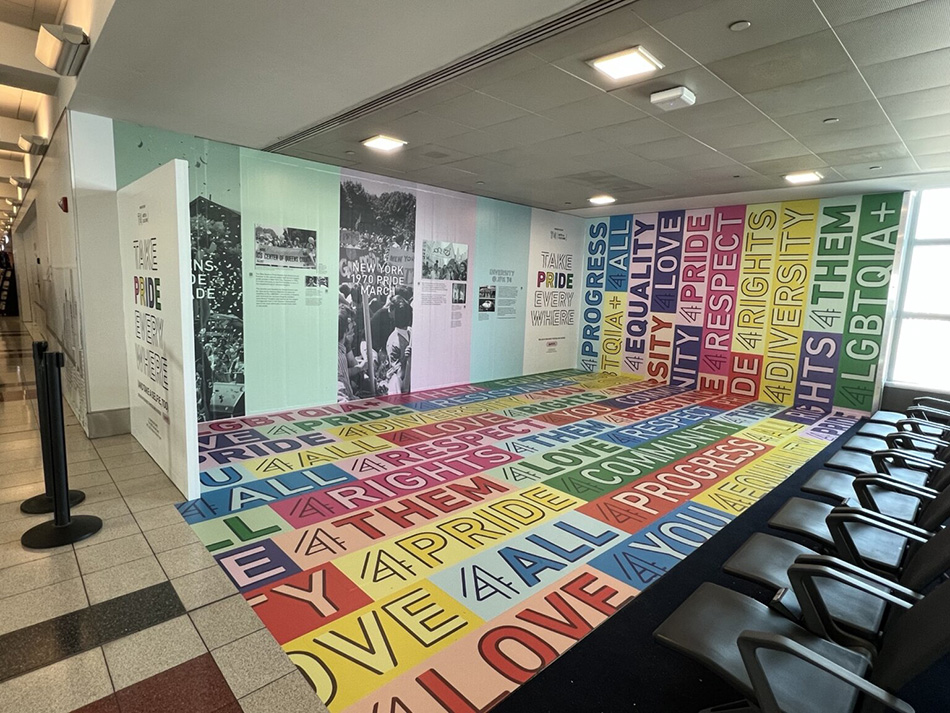
This pop-up museum highlights a range of artwork and historical pride information. Travelers who stop by will also have numerous photo opportunities.
One of the main purposes of the museum is to teach those who view it about bout the LGBT Network, NYC LGBT Historic Sites Project, Queens Pride Parade, New York City’s first-ever Pride March and diversity. The installation can be found at Concourse B near Gate B25.
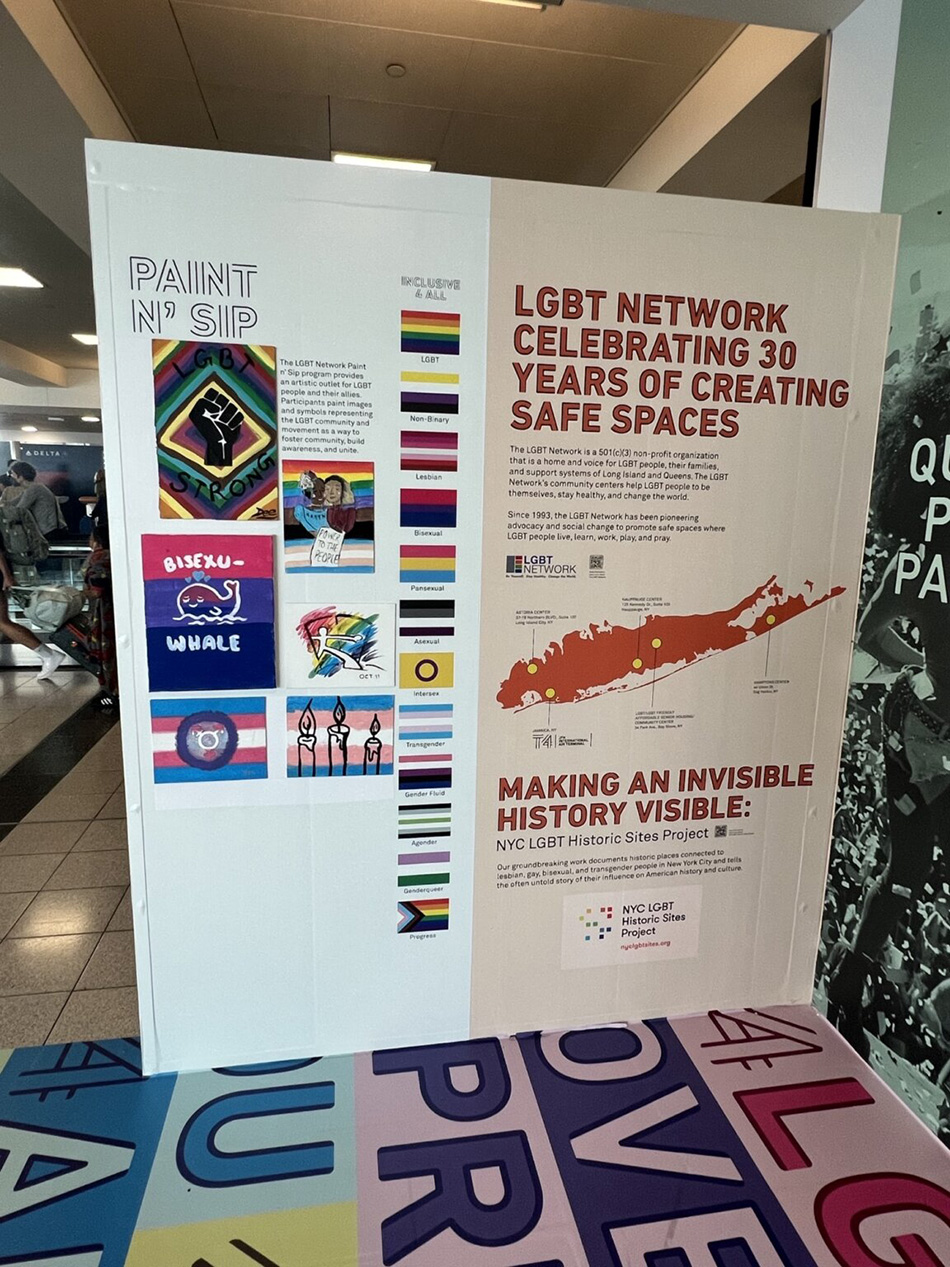
JFKIAT Senior Manager of Customer Experience Julia Moris said the pop-up exhibit, which was installed on June 1, was developed as a way of celebrate diversity and equality, as well as informing travelers about the history of Pride Month. Additionally, this pop-up offers resources to those who may be in need of them.
“We are honored to have had the opportunity to partner with the LGBT Network and NYC LGBT Historic Sites to present the Pride Pop-Up Museum in JFK’s Terminal 4, in collaboration with Richard Shpuntoff, who photographed the first-ever Queens Pride Parade,” Moris said. “As a Queens-based company that is dedicated to diversity, equity, inclusion and belonging, it is important that we foster a welcoming, vibrant environment within our terminal that represents and celebrates the diverse communities around us. The Pride Pop-Up is a wonderful way to commemorate Pride Month at T4 and we are pleased to see our community enjoying this experience.”
JFKIAT is the operator of Terminal 4 of JFK International Airport in Jamaica.
‘Places Of Pride’ Historic LGBTQ Sites Highlighted On LinkNYC Kiosks
June 23, 2023
By: Peter Senzamici
A partnership with the NYC LGBT Historic Sites Project helped create the city’s first map of LGBTQ historic sites.
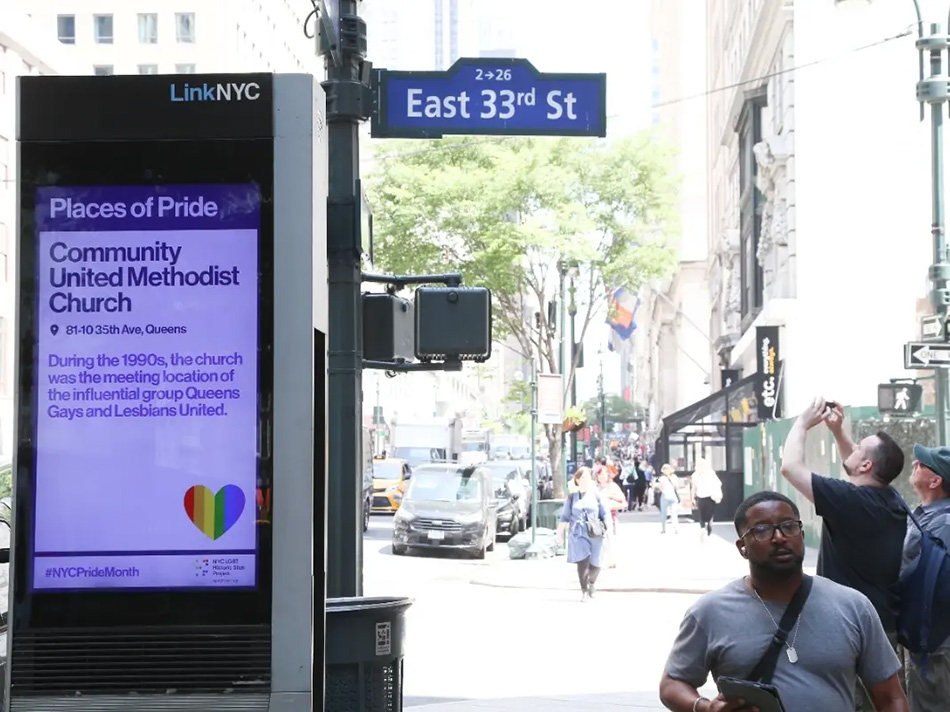
UPPER EAST SIDE, NY — During the last weekend of Pride Month, all New Yorkers can learn a bit more about the LGBTQ history in their own neighborhoods just by taking a walk around.
This weekend and throughout the entire month of June, LinkNYC partnered with the NYC LGBT Historic Sites Project, a scholarly initiative and educational resource that has contributed to the creation of the city’s first map of LGBTQ historic sites.
“Our mission at LinkNYC is to help New Yorkers connect with each other, and our relationships with community organizations help us foster this connection through technology, education, and the promotion of New York City values like equity and diversity,” said Nicole Robinson-Etienne, LinkNYC’s director of external affairs.
The fact is, LGBTQ history is all around us.
“Sites of Pride” will highlight local historical sites — from the 17th Century to the millennium — all over the city on over 3,600 LinkNYC screens in the Big Apple.
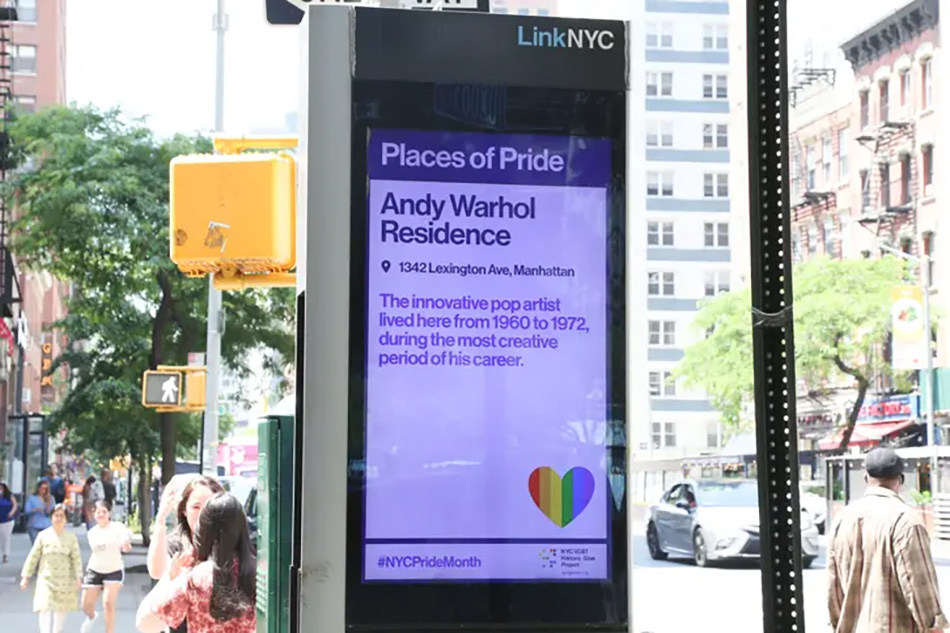
They also identify vital gathering spaces, including bars, clubs, and community centers, which, until recently, were often the only places where LGBTQ individuals could truly be themselves, given the limitations in their personal and professional lives.
For example: many people know that Andy Warhol lived on the Upper East Side, but did you know that the hugely influential Gay Activists Alliance was founded in 1969 inside Jim Owles’ East 61st Street apartment?
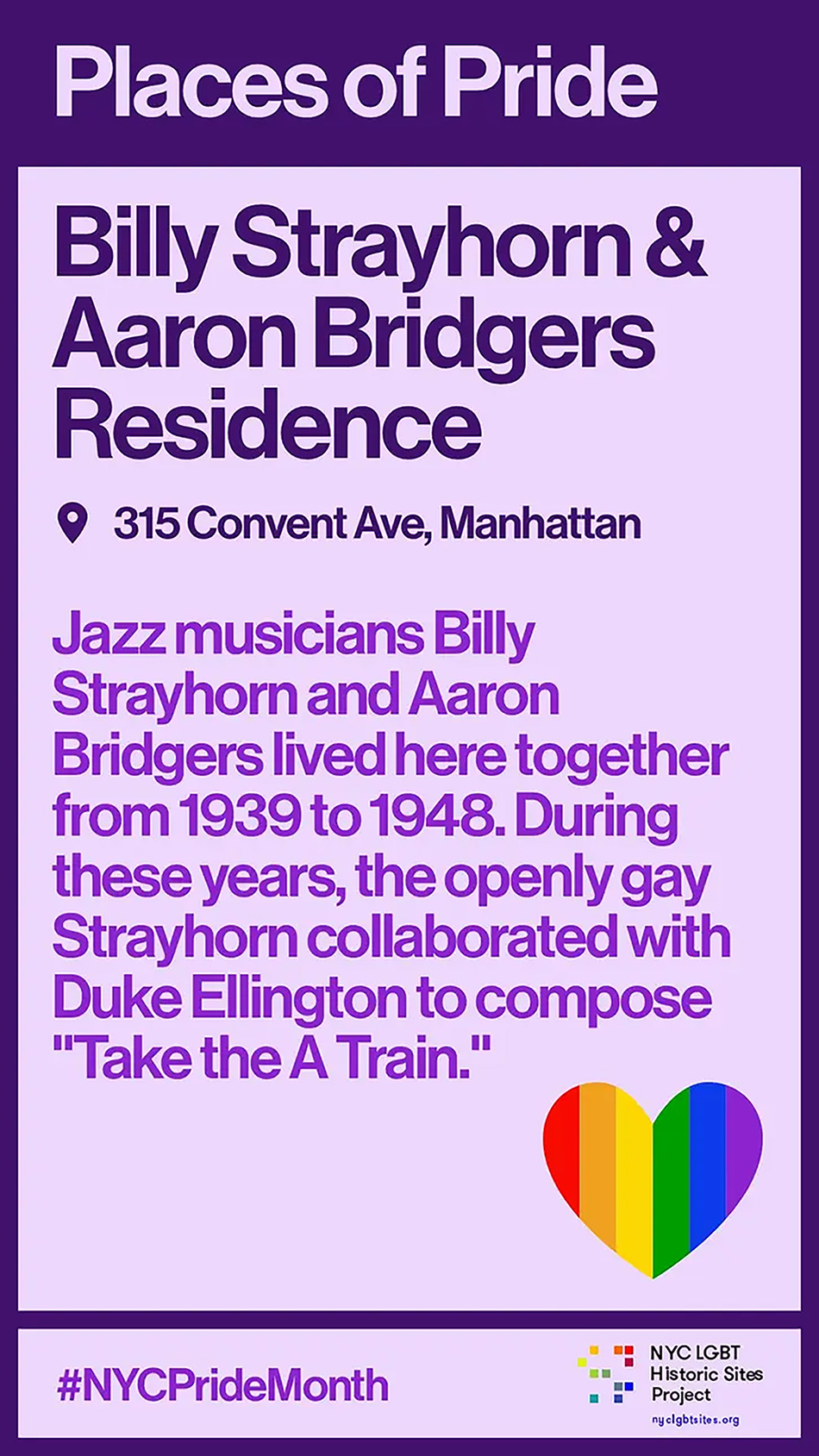
LinkNYC also partnered with The Gatekeepers Collective for Pride Month, a self-reclamation center where participants commit to unlearning internalized racial and sexual oppression, integrating their multiple identities, aligning with their leadership potential, and becoming proactive change agents in their communities.
“LGBTQ visibility is powerful tool, and any chance to partner with allies can educate the public and lead to larger conversations about equality and acceptance,” said Ken Lustbader from the NYC LGBT Historic Sites Project. “There are important historical sites all around our city, and we are proud to partner with LinkNYC to bring these valuable sites to New Yorkers this Pride Month.”
Other examples of sites on the interactive map include:
- Pyramid Cocktail Lounge, 101 Avenue A
- Frank O’Hara’s Residence, 441 East 9th Street
- Ernestine Eckstein’s and Allen Ginsberg’s Residence, 437 East 12th Street
- Stewart’s Cafeteria, 116 Seventh Ave South
- Mattachine Society Office, 59 Christopher Street
- Stonewall National Monument at Christopher Park
- Oscar Wilde Memorial Bookshop, 15 Christopher Street
- Circle Repertory Company Theater, 99 Seventh Ave South